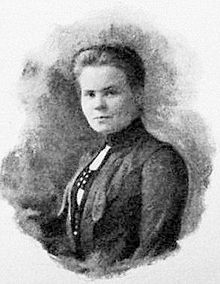| Sarolta Steinberger | |
|---|---|
 Sarolta Steinberger Sarolta Steinberger | |
| Born | 12 September 1875 Tiszaújlak, Austria-Hungary (today Vylok, Ukraine) |
| Died | 24 November 1965 (aged 90) Budapest, Hungary |
| Nationality | Hungarian |
| Other names | Charlotte Steinberger |
| Education | Eötvös Loránd University |
| Occupation | Doctor |
| Known for | first woman doctor to qualify in Hungary |
Sarolta Steinberger (12 September 1875 – 24 November 1965) was one of the first women to qualify as a physician in Hungary.
Life
Steinberger was born in Tiszaújlak, Austria-Hungary (today Vylok, Ukraine) in 1875 to affluent Jewish parents. She attended private schools, and later she was educated in Kolozsvár (today Cluj-Napoca, Romania).
In December 1895, the newly appointed Minister of Education and Religion, Gyula Wlassics passed a law that allowed women, and Steinberger, to attend Eötvös Loránd University in Budapest to study medicine. In 1900, the Sunday News reported that Steinberger had qualified as a doctor. She was the first woman to achieve this qualification in Hungary. Vilma Hugonnai, who was a Hungarian countess, had qualified as a doctor in Zürich around 1879. but was only allowed to practise as a physician in Hungary in 1897.
After she qualified as a doctor, she first studied gynecology abroad for two years. When she returned to practise in Hungary she joined the Feminist Guild. Steinberger lectured and in 1902 she wrote a series of articles on The History of Doctors.
She worked at the Tauffer clinic which had been founded by William Tauffer in 1888. In 1913, the law was changed so that women doctors no longer needed a male doctor to work with them. In 1928, she became the director of the National Social Insurance Institute.
World War II
Steinberger may have been able to leave Hungary in 1938 after the Nazis annexed the country. Her case was championed in the USA with leading suffragist Carrie Chapman Catt. World Peace Prize winner Rosika Schwimmer approached Catt to sign a letter in support of Eugénia Meller and Sarolta to emigrate to the USA. Catt refused to sign the letter. She noted that she was old and the letter would remain after her death.
Steinberger was the director of the National Social Insurance Institute until 1944 when the laws against Jews working prevented her from continuing her profession.
Steinberger retired and died in Pesthidegkút near Budapest in 1965.
References
- Sanger, Margaret (1 October 2016). The Selected Papers of Margaret Sanger, Volume 4: Round the World for Birth Control, 1920-1966. University of Illinois Press. p. 120. ISBN 978-0-252-09880-2. Retrieved 22 November 2022.
- ^ Women can also study at Hungarian universities, Hirek.sk, 19 December 2011; retrieved 21 April 2017.
- ^ Steinberger Sarolta (1875-1966) is a doctor, a feminist, Mamika, 30 May 2015, Nokert.hu, Retrieved 21 April 2017
- Honti, József (2010-07-25). "Dr. Sarolta Steinberger, the first woman physician at the Budapest Medical School". Orvosi Hetilap. 151 (30): 1236. doi:10.1556/OH.2010.30M. ISSN 0030-6002. PMID 20650816.
- ^ Jennifer S. Uglow & Maggy Hendry, The Northeastern Dictionary of Women's Biography, UPNE, 1999, pg. 268
- Francisca de Haan; Krasimira Daskalova; Anna Loutfi (2006). Biographical Dictionary of Women's Movements and Feminisms in Central, Eastern, and South Eastern Europe: 19th and 20th Centuries. Central European University Press. p. 334. ISBN 978-963-7326-39-4.